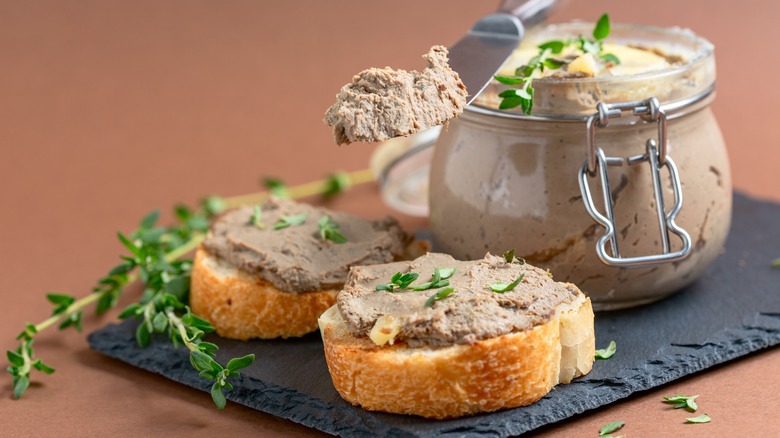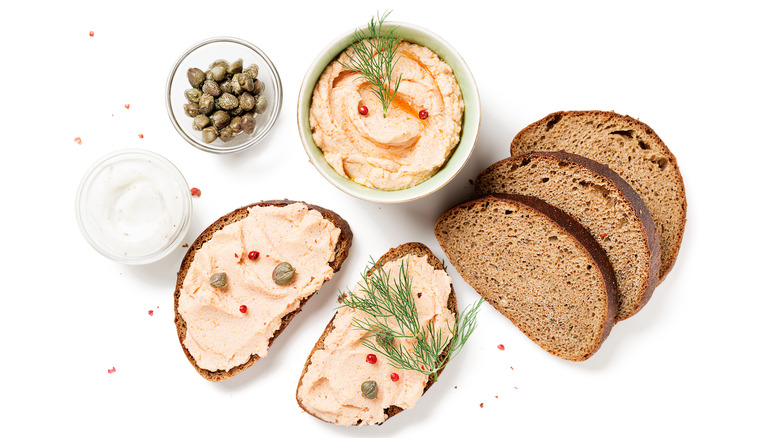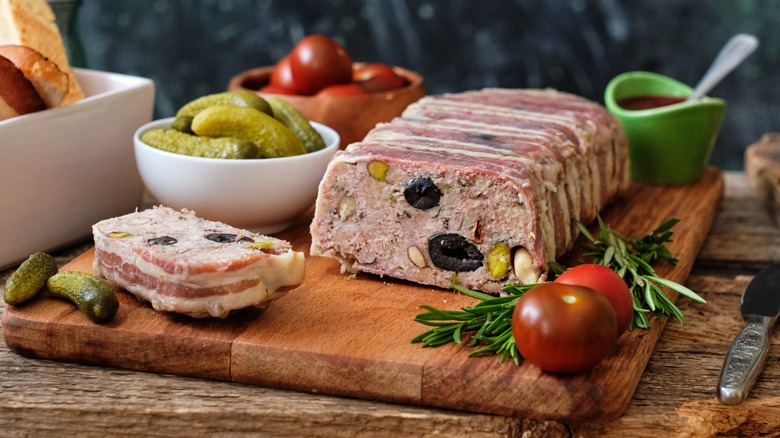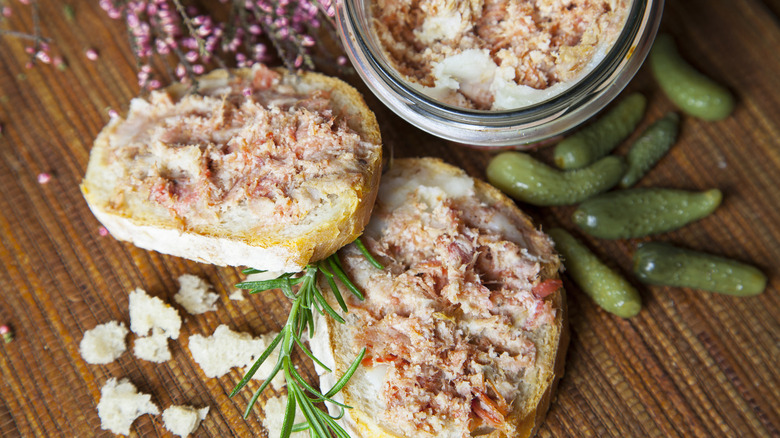What's The Difference Between Pâté, Terrine And Rillettes?
The reputation of France's food precedes the country itself. Sure, when discussing the European country, topics like art, architecture, fashion, and wine are mentioned, but it's the exceptional cuisine and contributions to the food world that many people seem to gravitate towards. Crêpes, onion soup, champagne, and camembert are quintessentially French, as are a group of meat delicacies that often get confused with each other.
Pâtés, rillettes, and terrines are staples in French cuisine, often served at parties as finger foods alongside other meats, cheeses, bread, and accompaniments like fruits and pickled vegetables. Really, they can be eaten anytime and, while some make their own, the three are widely available for purchase throughout the country. Pâtés, terrines, and rillettes are all considered forcemeats, or mixtures consisting of meat and fat, but they each have their own subtle differences. In short, pâtés are usually spread over bread but sometimes can be sliced, terrines are pâtés that are pressed into and cooked in dishes and are usually served sliced, and rillettes are chunkier than both and contain meat that is cooked confit-style (in its own fat).
These delicious dishes are no longer solely made in France, and they even go beyond meat, with seafood and even vegetable versions on the market. They are all interesting and tasty alternatives to cured meats and sausages and put an extra bit of flair onto any charcuterie board.
Smooth operator
Pâté is made by grinding or pureeing meat and fat into a smooth, spreadable, paste-like consistency. The meat can either be cooked initially and then ground, or, if it remains raw during the grinding process, the resulting pâté will be gently cooked in a water bath. It's generally flavored with various herbs and spices, and alcohol such as brandy or port wine. For consistency, butter, cream, eggs, or bread can be added as well. The flavor of pâté can be described as very savory and earthy, especially if liver is included in the mix. It can also have an interesting sweet background flavor based on the alcohol used for flavoring.
Prepared pâté can be molded into a shape before serving, but it's often placed in a dish or scooped out with a spreading knife to place on toasted bread or crackers. One of the most popular and recognized pâtés is pâté de campagne, which is made with pork and has a chunkier consistency than smooth pâtes. You can also often find pâté en croute, which is wrapped in pastry and baked.
There are four categories of pâté: Country pâté has a coarser texture (pâté de campagne falls under this category), straight pâté is smoother, gratin pâté boasts a richer flavor as the meat is well-browned prior to processing, and mousseline pâté is the smoothest variety.
Terrine is just pâté in a dish
Terrine closely resembles pâté, as it also comprises a mixture of meat, fat, and flavorings. The key difference is that the blend is placed and cooked in a terrine mold. To serve, terrines are often turned out of the dish, cut into slices, and eaten with a fork and knife with things like cornichons, mustard, and bread. Terrine, though, doesn't necessarily have to be a variety of pâté because it doesn't have to be made of meat. You'll find some terrines that are made of vegetables, chicken, game meat, or seafood.
Terrine is an excellent choice for picnics (be it by the Seine or elsewhere) as the slices can be easily packed and transported. You might consider a terrine as an upscale version of meatloaf, although such a comparison might meet with vehement disagreement from the French. Just ensure you refrain from smothering it in ketchup.
The coarsest of them all
Unlike pâté and terrine, which have a smooth texture, rillette tends to be made with shredded meat from pork, duck, or rabbit, but can also be found made of seafood like salmon and scallops. Also called potted meat, the meat is slowly cooked in fat, flavored with spices, and then ground but done so in a way where the finished product still has a coarse texture. Like pâté, rillettes are also meant to be spread on top of bread or toast.
It's common to open a jar or container of rillettes to find a layer of fat on top. This is totally normal and to be expected since rillettes are a type of confit. While confit is served hot, rillettes are served cool or at room temperature, and thanks to their high fat content, they have a considerable shelf life when stored correctly.
To the uninitiated, pâté, terrine, and rillettes might look unfamiliar and maybe a little intimidating, but when it comes to meat products, they are some of the most delicious in the world. Add in a fresh baguette, some seasonal fruit, and a great bottle of French wine, and you'll have a wonderful and memorable little piece of France in your own backyard.




